In the United States, numerous dangerous creatures exist. This article will explore a compilation of wildlife species with the greatest potential for causing harm. This list specifically includes animals that can physically assault humans through acts like biting, stinging, or scratching.
It’s essential to note that almost all untamed animals typically avoid engaging with humans and pose less danger unless provoked or caught unawares. When humans approach, most wild animals attempt to conceal themselves or flee.
With that said, here are 13 of the most aggressive animals in the United States, listed with no particular order:
1. Deer

Despite its docile nature, deer can be attributed to a number of deaths in the United States.
©iStock.com/EEI_Tony
The United States harbors creatures that pose a grave threat, and it’s not venomous spiders, fierce alligators, or gigantic bears. Instead, it’s the seemingly harmless deer that takes the crown. LCB analyzed data from the CDC and compiled a list of the 16 most deadly creatures residing in the country. Surprisingly, these formidable contenders do not wield the expected arsenal of paws, claws, fangs, or venom.
Deer cause an average of 120 annual deaths. In stark contrast, bears, alligators, and sharks each claim a single human life every year, while rattlesnakes are responsible for only 0.23 human fatalities within the same period. Despite deer’s formidable appearance, characterized by their imposing antlers and strong hooves, their lethal outcomes don’t stem from piercing or trampling. Instead, these incidents arise unexpectedly through events such as car crashes, where the sudden presence of these harmless creatures prompts drivers to swerve or collide.
Although deer significantly contribute to the mortality rate, the root cause of this issue ultimately lies in human actions. The situation may be worsening; as human expansion continues, we infringe upon the natural habitats of deer, increasing the likelihood of harmful interactions between humans and these animals.
2. Bees, Wasps, and Hornets
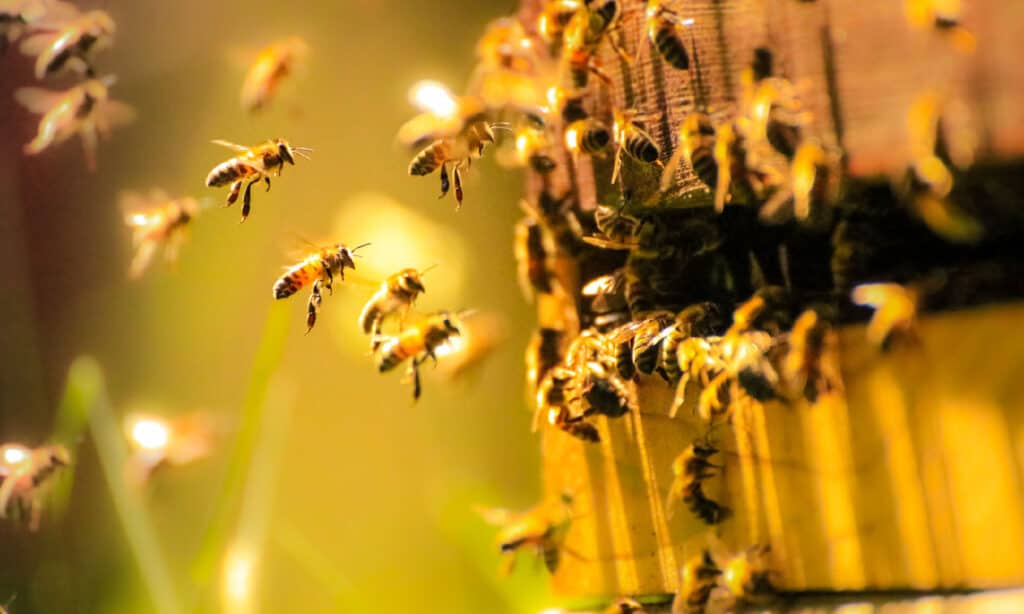
These industrious insects are classified among the most aggressive animals in the United States and command respect and caution.
©iStock.com/William Jones-Warner
Approximately 58 individuals meet yearly demise due to being stung by these insects. The most effective action involves adopting preventive measures to avert such perilous encounters. These particular insects commonly employ their stingers to protect themselves, as well as their hives and nests.
Africanized honey bees, also known as killer bees, pose a significant threat due to their tendency to swarm and attack intruders in larger groups than European honey bees.
Thwarting unwanted bee or wasp intrusions necessitates abstaining from factors that might attract them and refraining from provoking their anger while they coexist in the vicinity.
3. Dogs

Dogs, known for their loyalty and companionship, are also recognized among the animals with the potential for aggression.
©iStock.com/VictorRicoFoto
The study of fatal dog-human incidents over the years has sparked heated discussions due to the complex factors involved in each attack. From 2005 to 2019, dogs caused 521 deaths in the United States. Pit bull attacks caused over 65% of these fatalities. It is astonishing, considering pit bulls make up a minor fraction — about 6% — of the overall canine population in the country.
Following pit bulls, Rottweilers ranked second with 45 fatalities, while German shepherds came in third place with 20 recorded attacks resulting in deaths. Surprisingly, even breeds known for their friendly nature, like Labrador retrievers, have unexpectedly made it into the top 10 list with nine documented incidents.
4. Livestock (Cows and Horses)
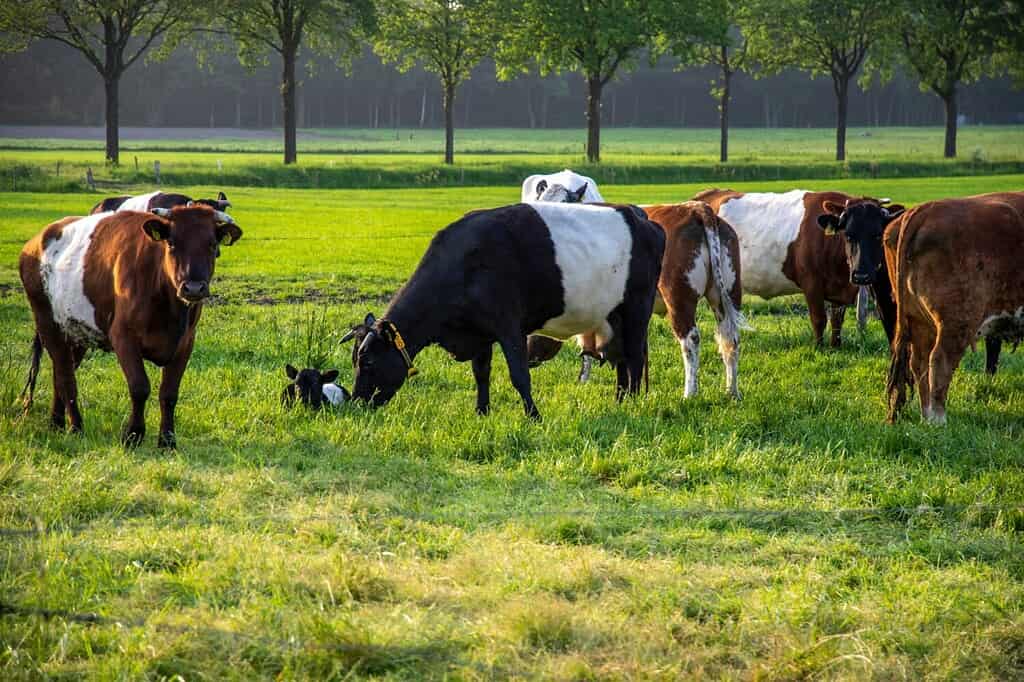
Though typically docile, it’s crucial to exercise caution and maintain a safe distance as cows possess the potential for aggression, especially when protecting their young or feeling threatened.
©Fred Schuch/Shutterstock.com
Other creatures besides wild animals have the potential to cause fatalities. Despite being perceived as slow-witted animals, cattle in the United States are responsible for approximately 20 human fatalities annually. Cattle possess pointed and potentially harmful protrusions; even without them, they are robust creatures capable of causing harm. Cows use their compact skull bone as a tool for combat. They have remarkably thick skulls and a natural tendency to charge at any potential danger.
New mothers can be risky to approach because they tend to be highly vigilant and defensive of their young calves. Humans frequently underrate the risk cattle present due to their leisurely pace and mild temperament. Although they can move with incredible speed, they channel all their considerable mass into each of their assaults.
Furthermore, cows are instilled with a lively and inquisitive nature, prompting them to make numerous attempts to engage in playful activities with humans. They practice their self-defense techniques of head-butting and charging, which could be fatal to a human, as their way of playing. The cow often causes harm unintentionally, although it is responsible for the injury in most cases. Despite their revered status, horses are responsible for around 100 deaths annually in the United States due to equestrian pursuits such as riding accidents.
5. Bears

The spirit of these untamed and formidable creatures reminds us of their potential for assertiveness when defending their territories or seeking food.
©Ghost Bear/Shutterstock.com
Bears often display remarkable composure and restraint when encountering humans. If given the chance, bears prefer to distance themselves from human company. Surprisingly, many individuals remain oblivious to a bear’s presence until it mysteriously vanishes into the forest. Year after year, countless human-bear encounters occur without harming either party.
Though rare, instances of humans encountering bears can result in severe injuries or even death for the humans involved. Among all bear species, polar bears and grizzly bears are deemed the most dangerous to humans. Even so, these animals exhibit significant intelligence and typically lack an inherent inclination to pursue or harm humans without provocation. Multiple reasons exist to account for a bear’s potential motivation to launch an attack on a human.
For example, bears with their young ones can present a danger since they are extremely protective and will do whatever it takes to keep their offspring safe. Humans and other creatures are often considered risks and can endure physical injuries like attacks, bites, or even fatalities from bear encounters. Additionally, bears guarding their food are exceptionally vigilant and can pose a substantial hazard to humans.
6. Spiders
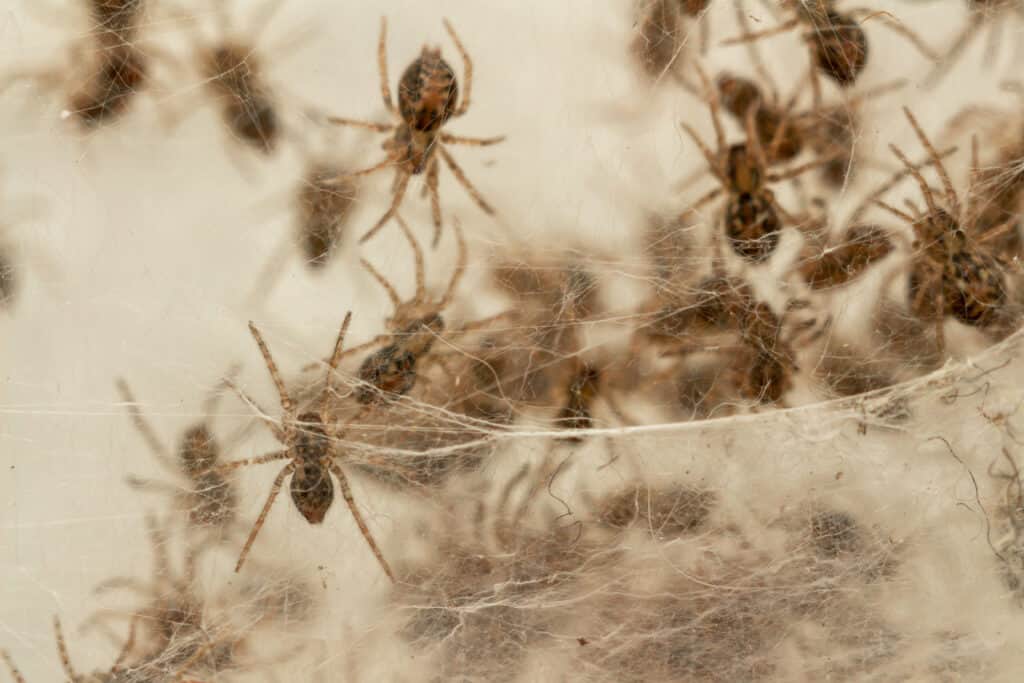
Spiders are known for their diverse species and occasionally aggressive behavior.
©Ivan Semenovych/Shutterstock.com
There are over 43,000 distinct types of spiders present globally. Out of all these, just a few are considered dangerous, and fewer than 30 (less than 0.1%) have caused human fatalities. Spider venom has properties that specifically target smaller animals. However, the venom in certain spider species can lead to skin damage or severe allergic reactions in humans, which may result in death. It’s crucial to acknowledge that fatalities from spider bites are exceedingly rare as medical facilities typically maintain distinct antivenins for different spider species to address any bite effectively.
An average of seven people per year died from spider bites between 2001 and 2013. The brown recluse spider is one of the deadliest in the U.S., mainly found in the southern regions. It has six eyes instead of eight, a violin-shaped marking on its back, and a hairy abdomen. Brown recluse spiders — typically non-aggressive — usually only bite when threatened. However, accidentally disturbing them in your home can lead to a bite. If a brown recluse bites someone, seeking immediate emergency medical assistance is crucial since there is no effective commercially available antivenin. The skin tissue at the bite site can become infected, resulting in a large open wound. Symptoms of a bite include:
- Itching
- Nausea
- Fever
- Chills
- Kidney failure, seizures, and coma in severe cases.
7. Snakes
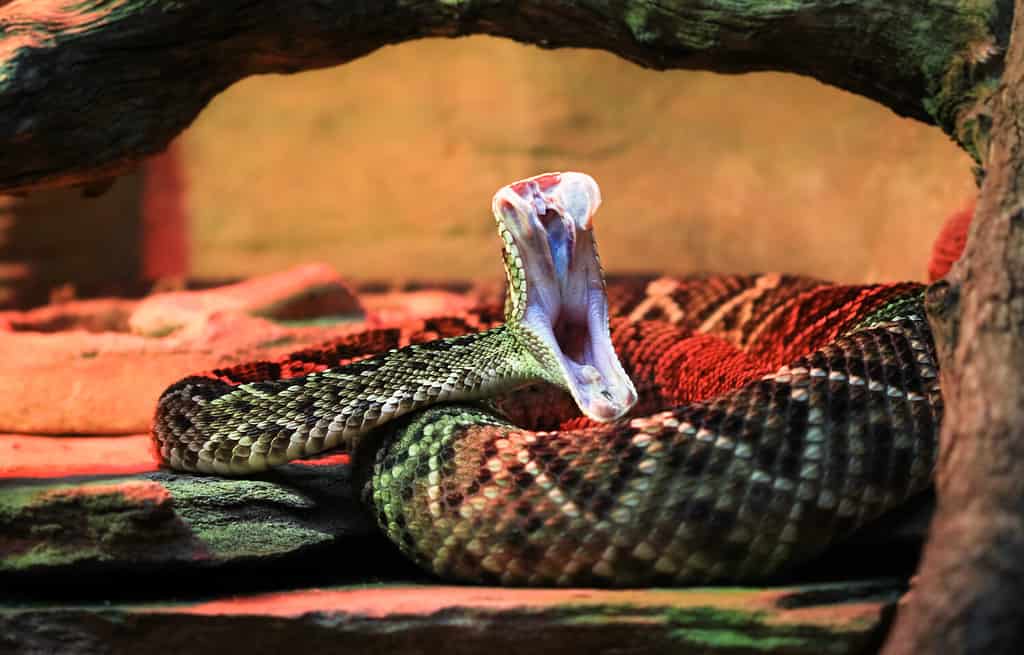
The eastern diamondback rattlesnake is not one to mess with. Known for its impressive size and aggression, it’s best to keep your distance.
©Kevin Wells Photography/Shutterstock.com
Snake bites within the United States rarely lead to fatalities. Approximately 7000-8000 Americans experience snake bites annually, but typically only 5 to 10 of these bites result in death. This astonishingly low ratio implies the likelihood of dying from a snake bite is 1 in 50 million. While America boasts numerous snake species, here are three of the most venomous:
- Eastern diamondback: The eastern diamondback, the largest among the three, is commonly feared. Surprisingly, it lacks significant aggression and only resorts to attacking when defending itself. Most snake bites occur when humans provoke or attempt to harm them. Its venom is a potent hemotoxin that can destroy red blood cells and cause tissue damage.
- Copperheads: Copperheads, commonly encountered venomous serpents, bite more people annually than any other snake species. Unlike many venomous snakes, they lack clear warning signals and swiftly strike without prior notice. However, their bites seldom result in fatality.
- Cottonmouths: These partial sea serpents are known for their infrequent interactions with humans. However, when they do bite, the consequences can be scary and pose a significant danger. Their venom consists of hemotoxins, which can disintegrate blood cells and hinder clotting. Consequentially, hemorrhaging occurs wherever the venom spreads within the body’s circulatory system.
8. Mountain Lions
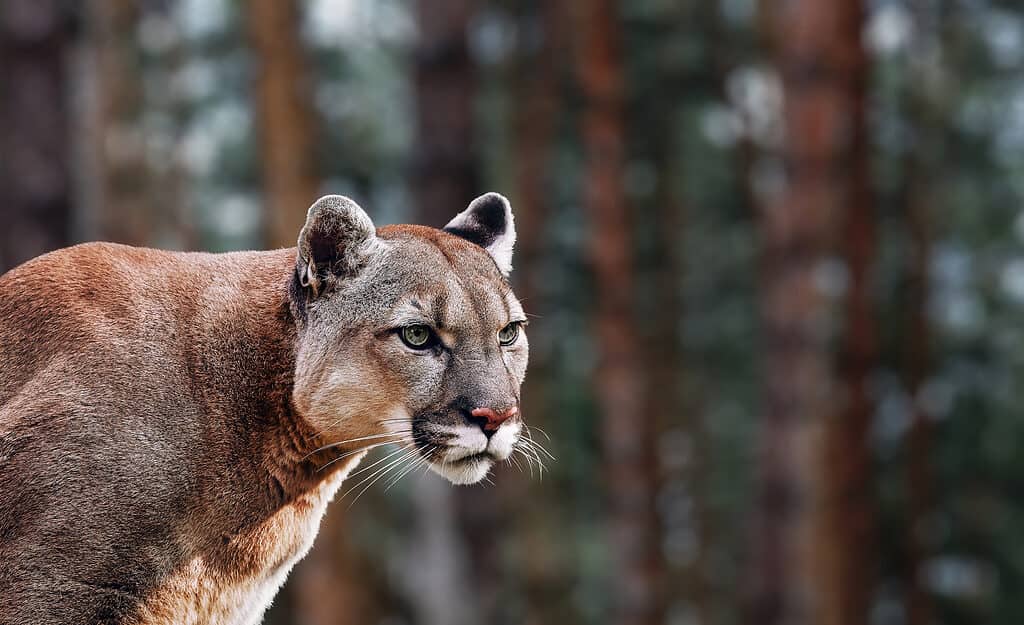
The majestic mountain lion is the epitome of power and stealth. With its piercing eyes and muscular stature, this apex predator easily takes down its prey.
©Evgeniyqw/Shutterstock.com
Mountain lions, known by monikers such as jaguars, cougars, and catamounts, inhabit North America as its largest wildcats. They possess formidable predatory skills, are armed with sharp claws, and can leap heights of up to 15 feet.
These massive felines roam across the territory spanning California to Texas, encompassing an estimated population of around 30,000 within the United States. However, the Florida pumas, a mountain lion subspecies, are comparatively less frequently encountered.
Your likelihood of falling victim to a mountain lion attack remains minimal. Attacks are infrequent and typically involve children or solitary adults as the unfortunate victims. Each year, four recorded mountain lion attacks have resulted in a single fatality, encompassing both the United States and Canada.
9. Alligators
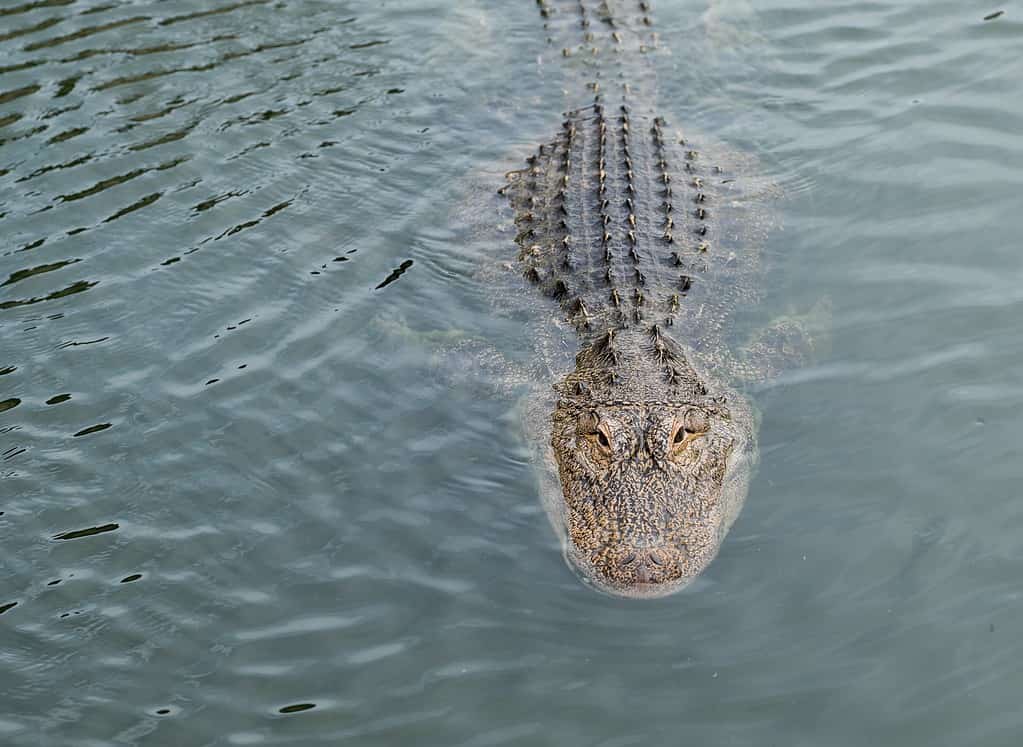
The alligator is an apex predator and one of the most aggressive animals in the United States. With its formidable jaws and armored scales, this ancient reptile commands both fear and fascination
©David Louis Tiffany/Shutterstock.com
Gators, those dangerous predators, dwell in aquatic domains like swamps, lakes, and bogs in the southeastern United States. These creatures resemble lizards, possessing formidable tails and jaws. Florida houses approximately 1.3 million alligators, while their domain stretches extensively from North Carolina to the Rio Grande in Texas.
Although an incident occurred at Disney World in the past, fatalities stemming from alligator attacks are rare occurrences. Of the nine gator attacks in Florida in 2015, only one resulted in a death. Experts advise exercising prudence when dwelling in the habitat of potential predators, particularly during the twilight hours when their activity peaks, to evade being identified as prey.
10. Gray Wolves

Despite their physical ability to harm humans, wolf attacks are exceedingly rare, as they prefer to avoid humans.
©Nagel Photography/Shutterstock.com
The notorious “Big Bad Wolf” is consistently portrayed as the antagonist in children’s tales, but their truly unsettling and hair-raising characteristic lies in their haunting, bone-chilling howl. Gray wolves were largely eradicated in numerous states during the 1930s. Their habitats have significantly diminished, leaving a mere 5,500 wolves in the United States.
Despite their physical ability to harm humans, wolf attacks on us are exceedingly rare, as they prefer to avoid humans. Documented incidents of wild wolf attacks on humans in North America are extremely scarce, and there has never been a confirmed lethal attack.
If by chance you encounter wolves in their natural habitat, it would be unwise to hastily flee or abruptly avert your gaze, as such actions might awaken their primal hunting response. Instead, endeavor to exhibit a demeanor that appears intimidating in their eyes.
11. Scorpions
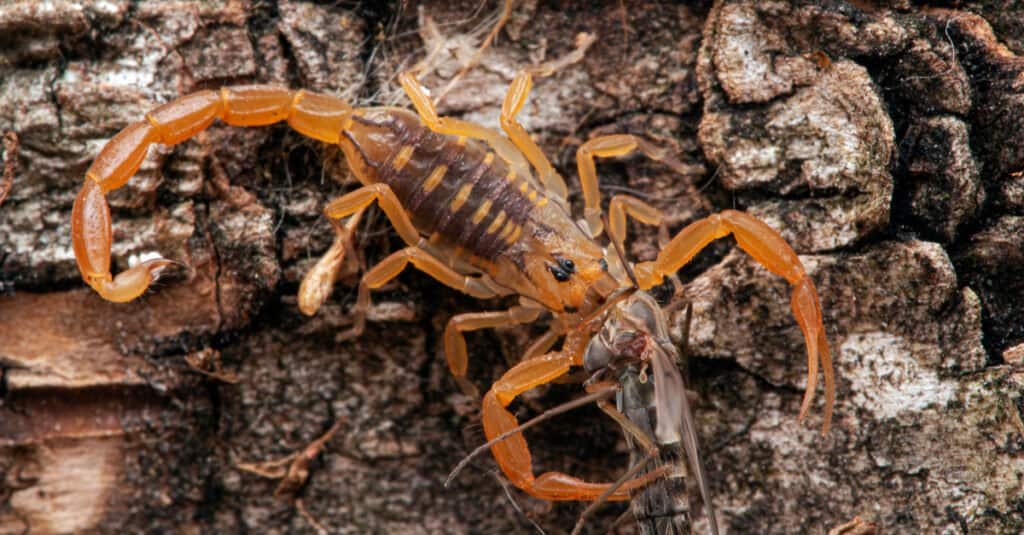
Equipped with a potent venomous sting and highly sensitive sensory appendages, the Arizona bark scorpion strikes fear in the hearts of its humans and prey.
©Ernie Cooper/Shutterstock.com
The Arizona bark scorpion holds the title of being the most venomous variety in America. This particular species is confined to the country’s southwestern part, yet it manages to infiltrate almost any location. It possesses the ability to scale walls, trees, and various rough surfaces due to its slender body. Its flexibility enables it to squeeze into tiny crevices effortlessly. The creature prefers to hide in shaded and moist areas, even taking refuge inside shoes.
Scorpions are prone to fleeing rather than initiating an attack when presented with the chance. The venom produced by this scorpion can cause intense and unbearable pain, accompanying symptoms such as numbness, excessive saliva production, breathing challenges, muscle spasms, and seizures.
12. Sharks
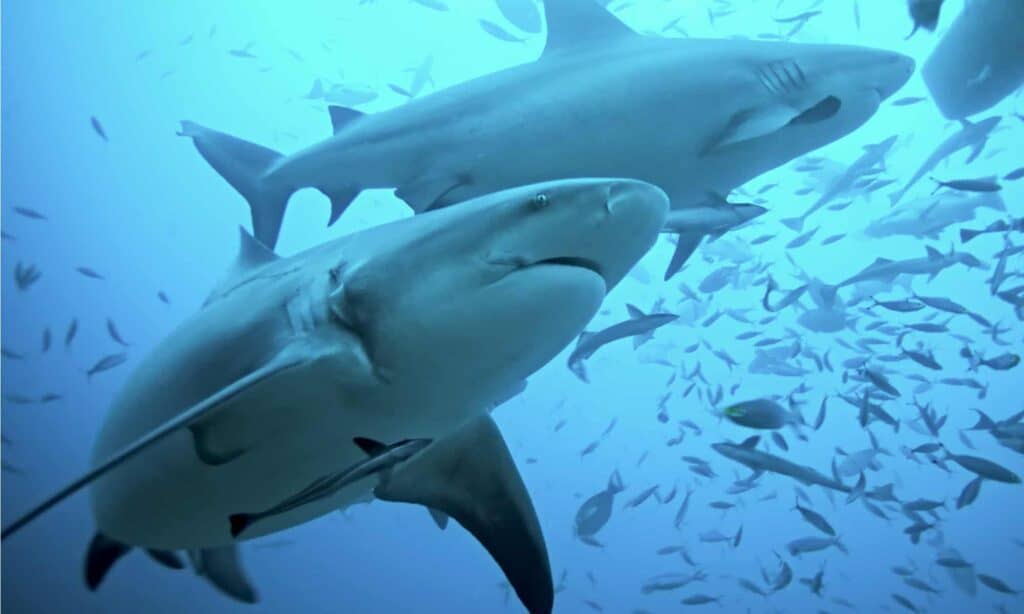
Known for its remarkable strength, agility, and ability to adapt, the
bull shark
exemplifies nature’s perfect predator.
©Martin Prochazkacz/Shutterstock.com
Sharks can evoke a sense of unease for those who have watched the film Jaws (1975). Among the diverse array of shark species inhabiting our oceans, there are a few that tend to be prominently associated with human attacks:
- Great whites
- Bull sharks
- Tiger sharks
While great whites may look bigger, bull sharks exhibit the most aggressive behavior. They also prefer to pursue their prey near the shorelines and shallower depths. It’s crucial to emphasize that sharks hardly ever pursue humans. And on the rare occasions when they do, it’s usually a case of mistaken identity — we humans are often mistaken for their usual prey like seals.
If you’re thinking about swimming in the ocean, it’s strongly advised to:
- Swim in groups
- Avoid swimming with open wounds
- Remove shiny jewelry
- Minimize excessive splashing
Moreover, avoid swimming during sunrise and sunset since those are the periods when sharks typically hunt.
13. American Crocodiles
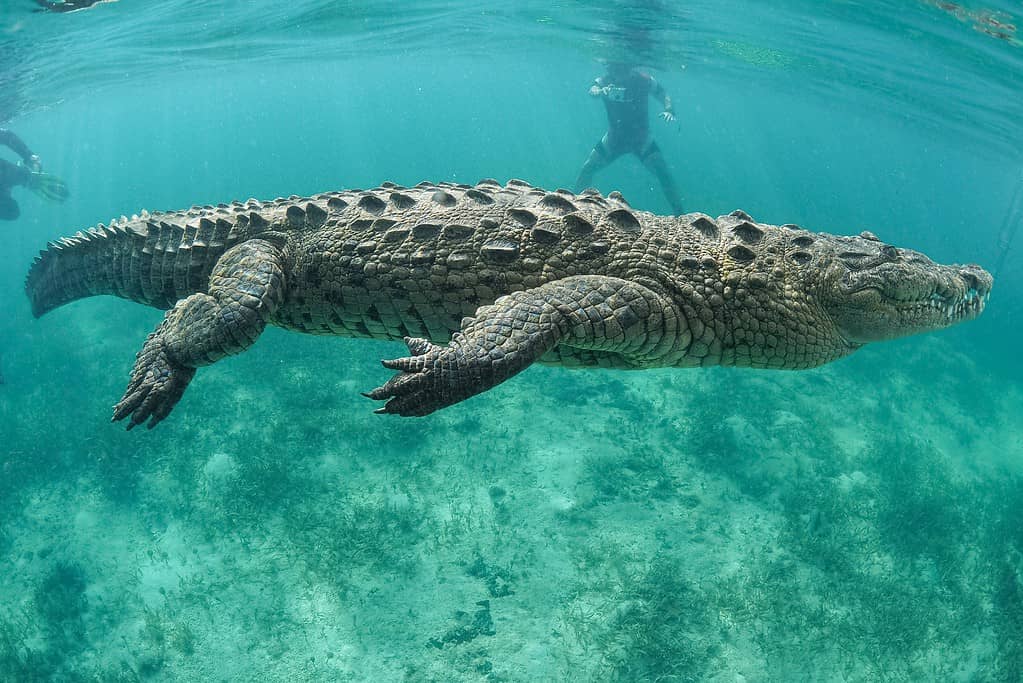
The American crocodile is known for its aggressive nature. Its powerful jaws and stealthy demeanor make it a fearsome contender.
©Jesus Cobaleda/Shutterstock.com
One can spot the American crocodile in southern Florida, reminiscent of prehistoric times. It differs from its relative, the alligator, in appearance with its elongated snout, lighter hue, and distinct pair of long teeth visible when its mouth is shut.
Unlike their more aggressive counterparts, the Nile and Australian crocodiles, American crocodiles display modesty and reserve, especially toward humans. They are much more inclined to retreat upon encountering people rather than attacking. In 2014, a peculiar incident unfolded in a Florida canal as two people took a plunge and unexpectedly became entangled in a crocodile’s jaws. This event marked the first documented encounter of humans with American crocodiles.
A Closer Look at America’s Deadliest Animals
We’ve examined the most aggressive animals in the United States, emphasizing their tendency to avoid interaction with humans unless provoked or protecting their young. The roster includes various creatures capable of inflicting harm through biting, stinging, or scratching. Surprisingly, the seemingly harmless deer ranks highest, causing the most annual fatalities.
Although interactions with these creatures have the potential to cause grave harm or fatality, such occurrences are uncommon. By implementing preventive measures, the likelihood of danger can be greatly diminished. Showing consideration for the dwelling places of these animals and adopting careful measures around them are crucial for guaranteeing the well-being of humans and animals alike.
The photo featured at the top of this post is © Chris Alcock/Shutterstock.com
Thank you for reading! Have some feedback for us? Contact the AZ Animals editorial team.







